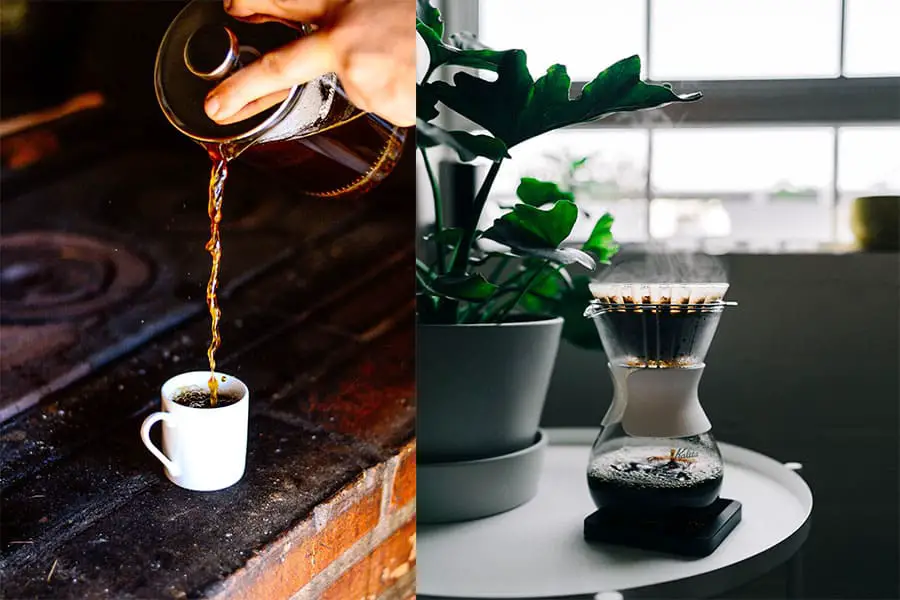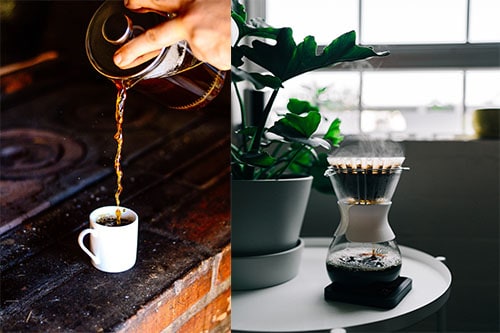
Coffee is coffee is coffee, right? Not necessarily. There are so many subtle differences that can make a huge impact on the taste of your morning cup of joe, from the species and geographic origin of a particular coffee bean to the coarseness of the grind to the brewing method used.
If you’re a coffee fanatic who’s on a quest to make the best-tasting cup of coffee of your life, you’ve probably spent a lot of time gathering the facts on all of the different variables that can affect your brew.
Today, we’re going to be talking about the difference between French press coffee and drip coffee, and the differences that these two brewing methods can make on your finished brew!
Before I begin to go into detail about these 2 brewing methods, lets get a basic understanding of the difference between them
The main difference between drip coffee vs French Press is drip coffee has water that is slowly passed over the coffee grounds that are on a thin piece of filter paper. In contrast, a French Press is coffee grounds that are placed in water for a set period time before being filtered out. The result is French press coffee has more oils and tastes stronger.
What is Drip Coffee?
If you haven’t yet dove very deep into the world of coffee, drip coffee is probably the brewing method that you’re most familiar with already. At its most basic level, drip coffee is simply made using hot water, ground coffee beans, and a filter. You pour the hot water over the coffee beans and through the filter, and voila! You’ve achieved a cup of drip coffee.
Most of the coffee machines that you see in diners, offices, and cafeterias are automatic drip machines, which use bulk amounts of water and coffee grounds to create a large carafe of hot coffee. Drip coffee can also be made using the pour-over method, which is much more labor-intensive but allows a significantly finer degree of control.
If you’re looking to achieve the best drip coffee results, you’re going to need to pay attention to a variety of different factors. Coffee connoisseurs recommend using filtered water or spring water, heated between 195°F and 205°F for the best results.
If you own an automatic drip machine, you likely won’t be able to manually adjust the water temperature. This is one of the reasons that many coffee connoisseurs don’t love using automatic drip coffee machines although that is changing rapidly with advent of new more “advanced” drip coffee brewers.
It’s also recommended that you freshly grind your coffee beans yourself, using a burr grinder designed specifically for coffee beans, not just a regular old food processor or blade grinder.
The ideal ratio of coffee grounds to water really depends on your personal taste, but a good starting point is about two tablespoons of coffee for every six fluid ounces of water. As you get more accustomed to the drip coffee process, you may end up tweaking the ratio to be stronger or more diluted, or whatever suits your personal taste.
You’re also going to want to your drip time to last around 5 minutes, which allows the hot water to interact with the coffee grounds for long enough to produce a fully developed and extracted result. Again, many models of automatic drip machine do not allow you to adjust the brewing time. If your coffee grounds are coarser, you may need to lengthen the brewing time a little, and if your coffee grounds are finer, you might want to shorten the brewing time a little.
As you can see, not all drip coffee is created equal, although the basic mechanisms of producing the coffee itself remain consistent. The temperature of the water, the coarseness of the coffee grounds, the type of filter used, the ratio of coffee to water, and the brewing time all make a huge difference in the quality of your drip coffee.
Finally, the type of coffee filter you use matters. Mesh filters are the best material for allowing the aromatic oils from your coffee grounds to permeate into your finished cup, but they require coarse, evenly sized coffee grounds that are almost impossible to achieve without a burr grinder. (They’re also reusable, and thus better for the environment!)
If you don’t have a (see my burr grinder post), or just prefer to use pre-packaged coffee grounds, a paper filter will work better for you. Don’t skimp on the filter quality — a thick, dense paper filter will provide the best results. Cheaper, thinner, flimsier filters are prone to breaking, which can cause disaster, but are also not as great at infusing aromatic oils and flavors into your finished cup of coffee.
What is French Press Coffee?
A French Press has also become a huge trend in the coffee industry over the past couple of years. Like pour-over coffee, French presses involve more manual labor on your part, but are widely touted for creating some of the best quality coffee out there. The parts that make up a French press machine are pretty simple.
It consists of a glass or steel outer cylinder, a handle, a metal mesh component, and a plunger. To make French press coffee, all you have to do is:
- Put the coffee grounds in the bottom
- Fill the cylinder with hot water
- Wait 4 minutes ( the hardest part)
- Press the plunger.
This allows the mesh component to filter out all of the coffee grounds, giving you a delicious cup of coffee! Of course, if you really want to fine-tune your French press experience for the optimal cup of coffee, there are some suggested guidelines that coffee connoisseurs often follow. You can check out my post on the French Press for more indepth information.
You’re going to want to use a medium grind on your coffee beans. Too coarse, and the water won’t extract enough flavor, giving you a weak, watery-tasting cup of coffee.
Too fine, and the grinds might slip through the holes in the mesh filter, making your coffee muddy and gritty. You’re also going to want to use a little over a tablespoon of fresh ground coffee for every six ounces of water. Of course, you can tweak this ratio as you grow more experienced with your French press.
The water temperature should be just under boiling or around 195 – 205 Fahrenheit, and you should let the water and coffee grounds sit for about three to four minutes before pressing the plunger down.
This gives the coffee grounds adequate time to steep, allowing the flavor and oils to infuse themselves into the water. If you follow these steps, you’re well on your way to perfecting the French press!
French Press Vs. Drip Coffee – Pros and Cons
Now that we’ve covered the basic how-tos for each method of coffee making, it’s time to dive into the pros and cons of drip coffee and French press coffee.
Die-hard French press fanatics will shout the benefits of the French press from the mountaintops, and die-hard drip coffee advocates will espouse the benefits of a good automatic drip machine or pour-over brew. In reality, French press coffee isn’t inherently superior to drip coffee, and vice versa.
The brewing method that’s best for you will depend heavily on your personal coffee tastes. If convenience and simplicity is your top criteria then a drip coffee maker should be your first choice .
Additionally, if you generally need to make bigger batches of coffee at a time, drip coffee is great, because many automatic drip coffee machines can make up to twelve cups of coffee at a time.
If you really enjoy a strong, customizable cup of coffee, A French press for example, from Bodum might be just the ticket for you. Automatic drip coffee machines are great for speed and convenience, but they don’t really allow you to fine-tune important variables like water temperature and brew time.
The process of making a cup of French press coffee is almost entirely manual, which allows you to experiment with your grind size, water temperature, brew time, and water-to-coffee ratio.
If you’re absolutely obsessed with achieving the perfect cup of coffee, a French press machine gives you much more versatility. Additionally, compared to an automatic drip coffee machine, the results you get from using a French press are often stronger, more complex, and more aromatic.
Final Thoughts
Researching coffee brewing methods can definitely be intimidating. Everybody has their own opinion on the kind of brewing method that produces the best results. When it comes to drip coffee vs French press coffee, the brewing method that’s best for you really depends on your personal preferences.
If flavor-infused beans, or really value speed and efficiency in your coffee-making process, drip coffee is the perfect brewing method for you. And in this case I would recommend that you consider the Bonavita BV1900TS. Here is the current price on Amazon if you think this is the way you want to go.
If you love having the power to control all of the different variables that go into your completed cup of coffee, from water temperature to grind size to brewing duration, then you’ll love using a French press! The one from Bodum is a great choice and the one I recommend.

